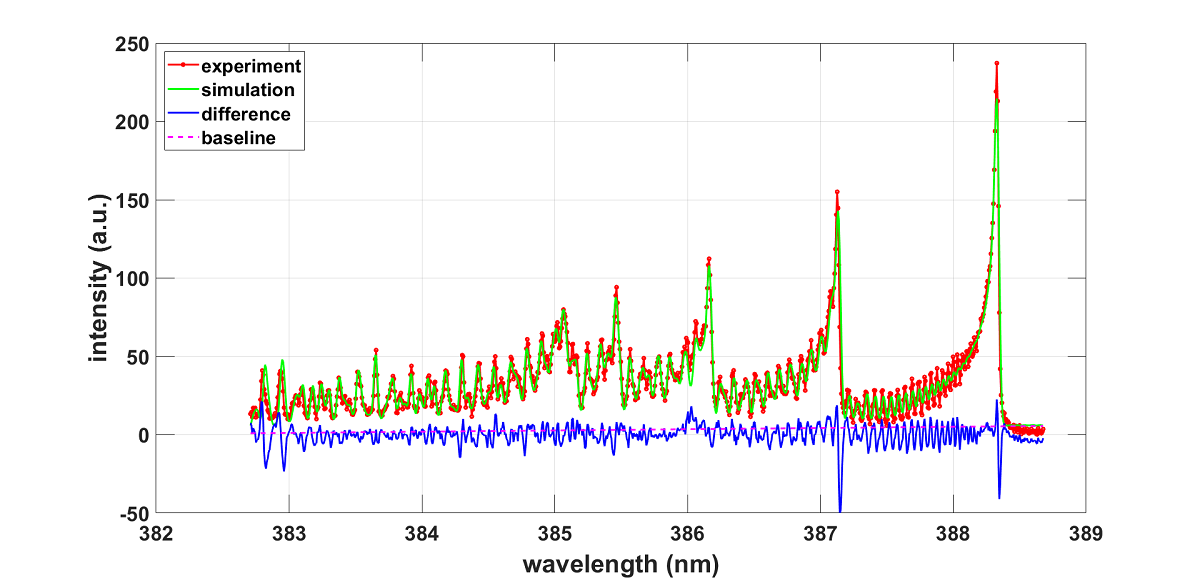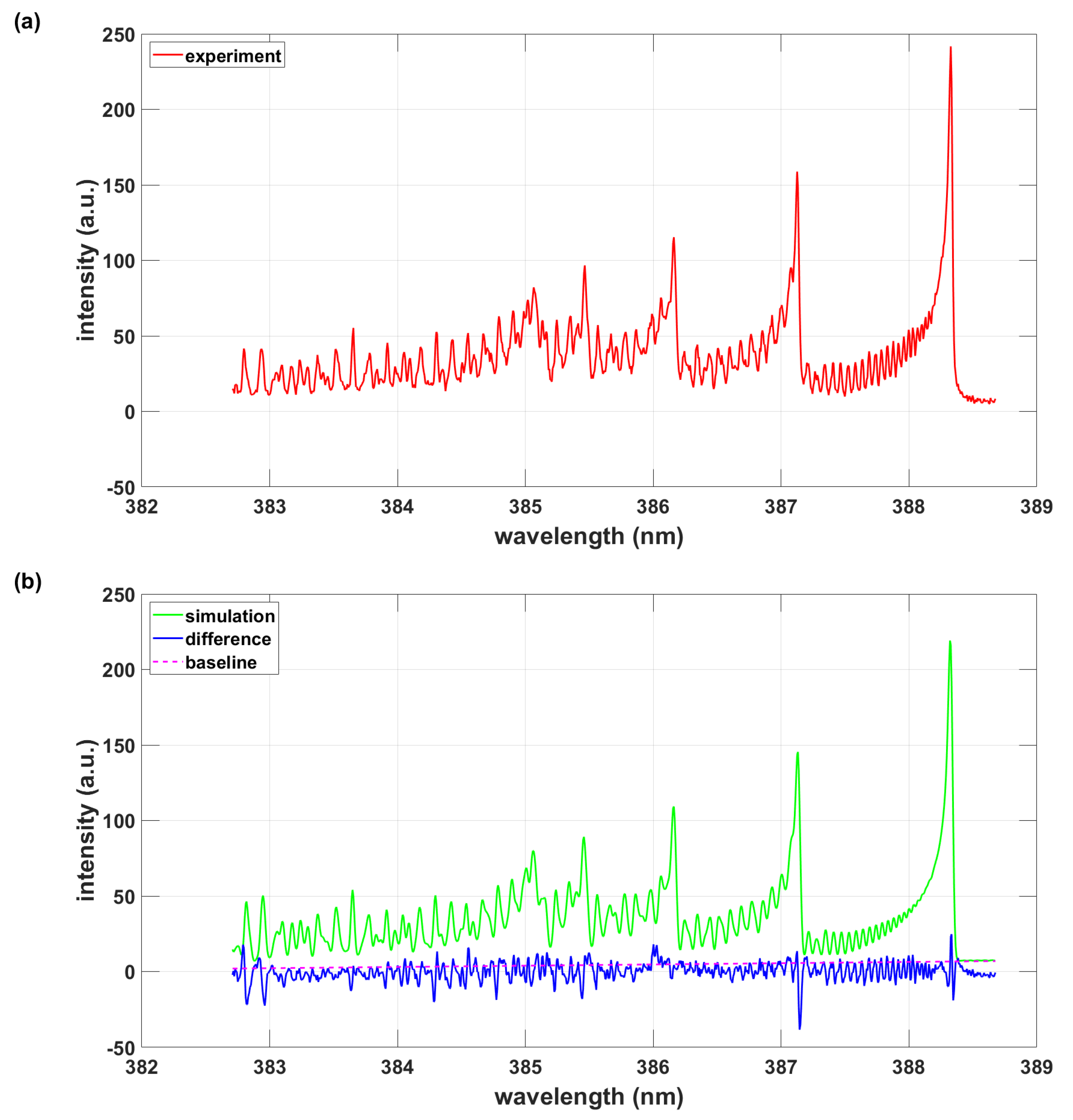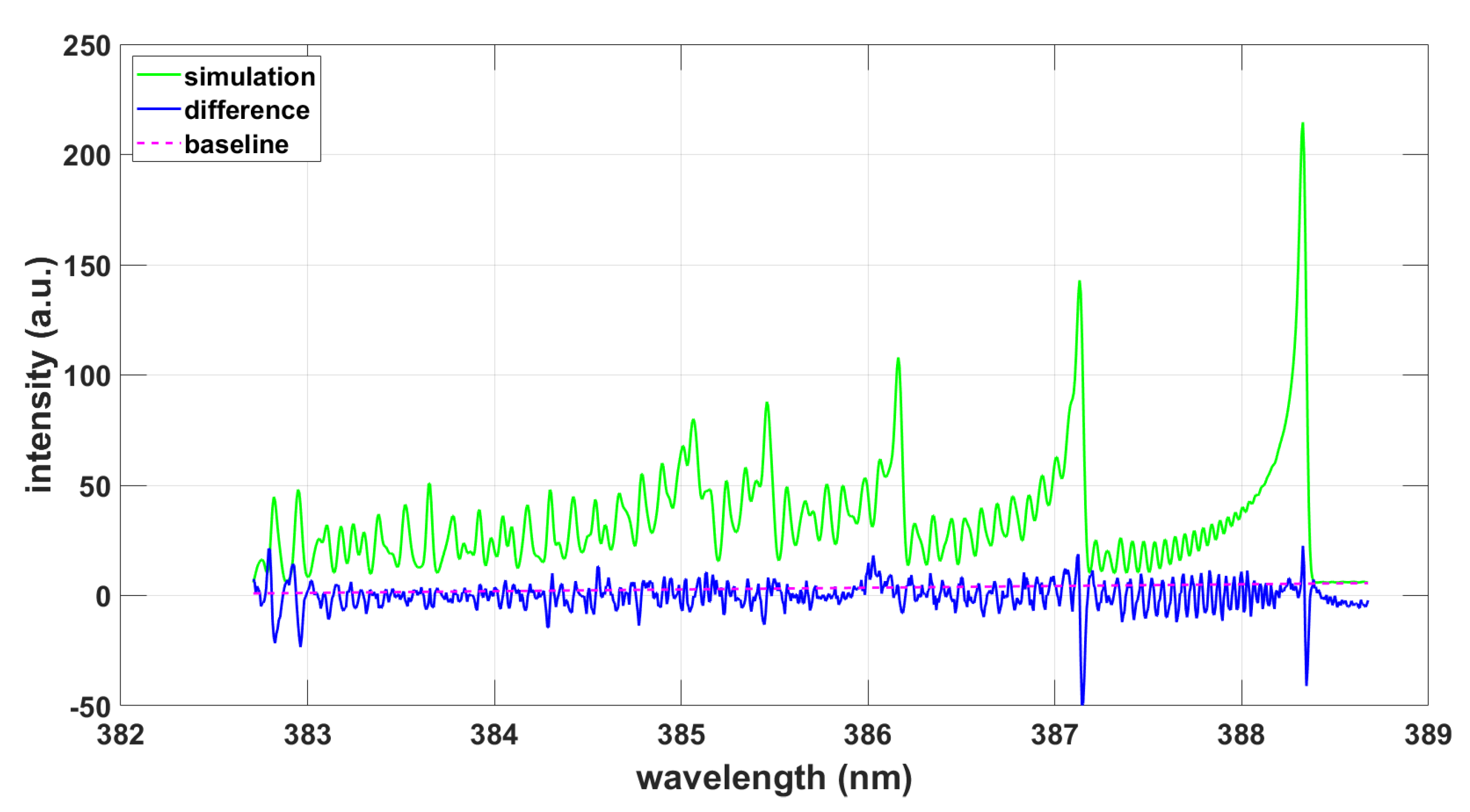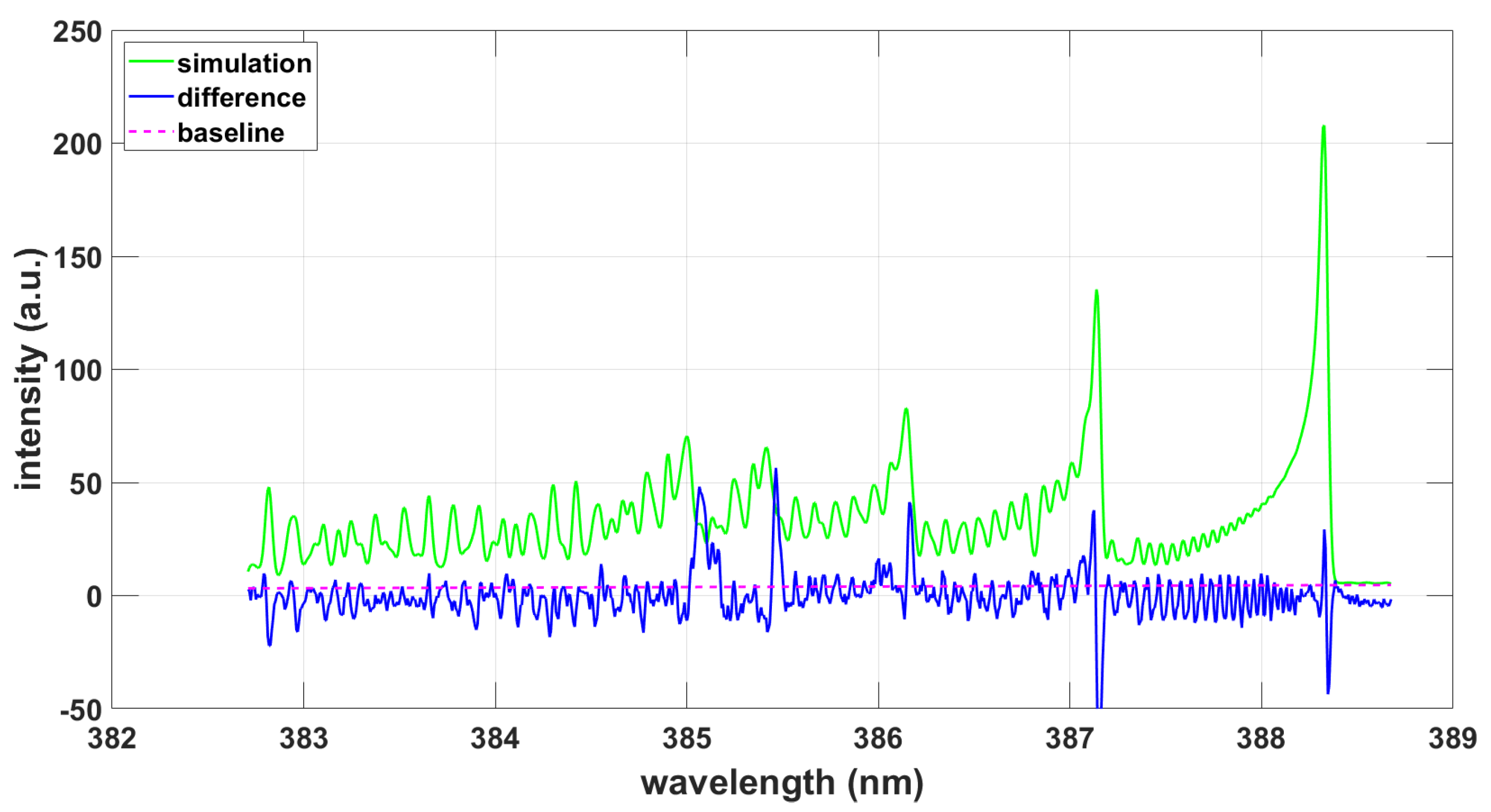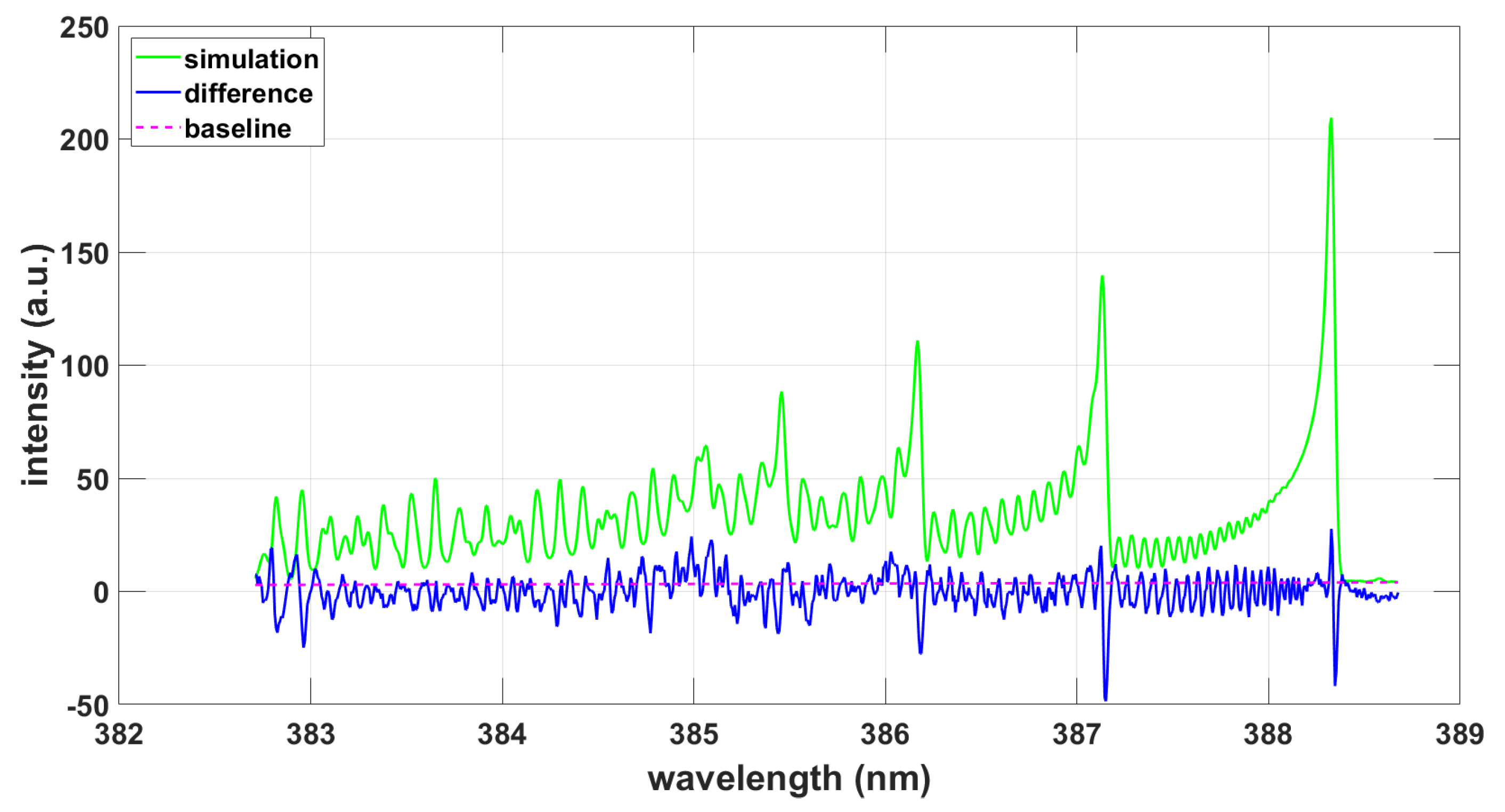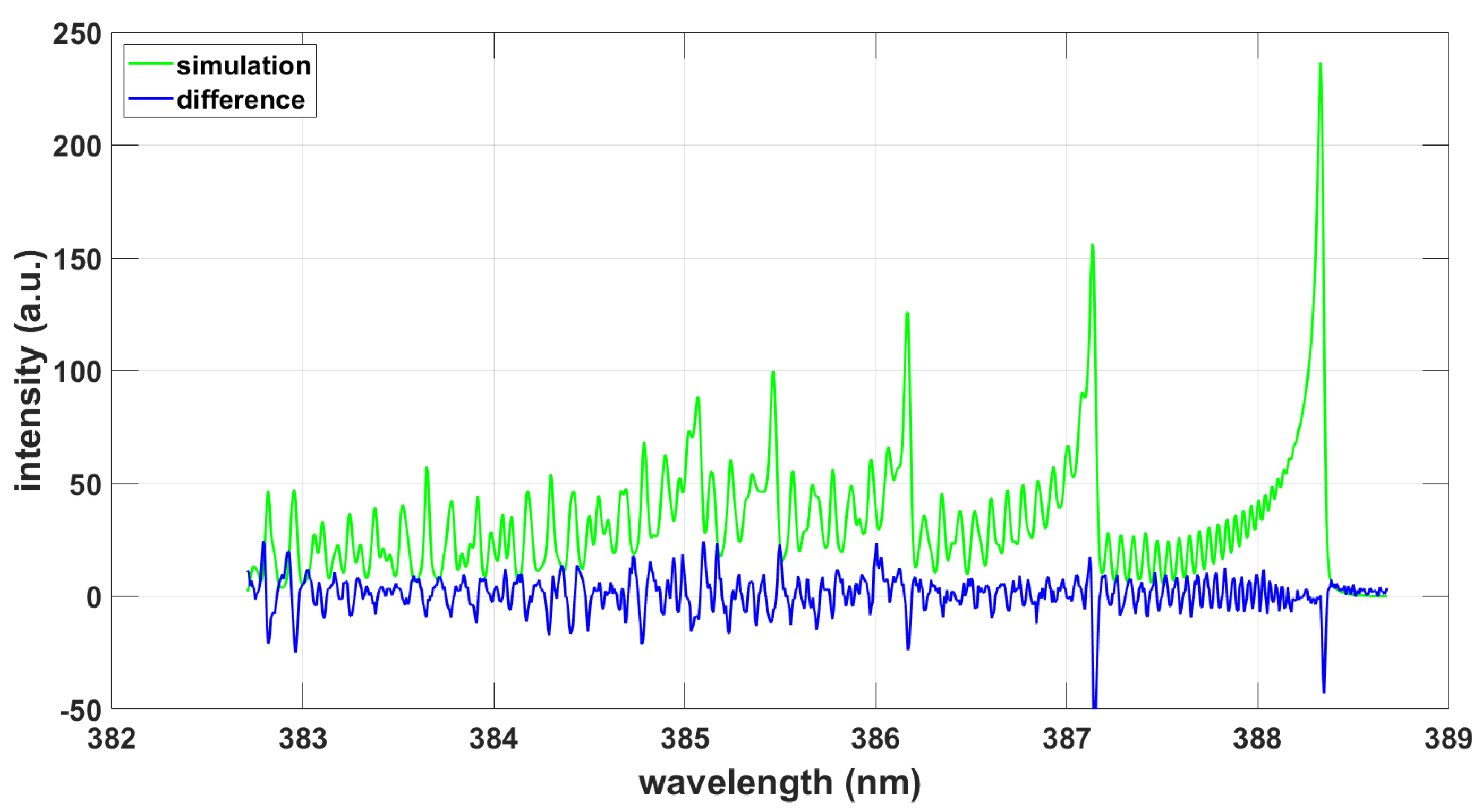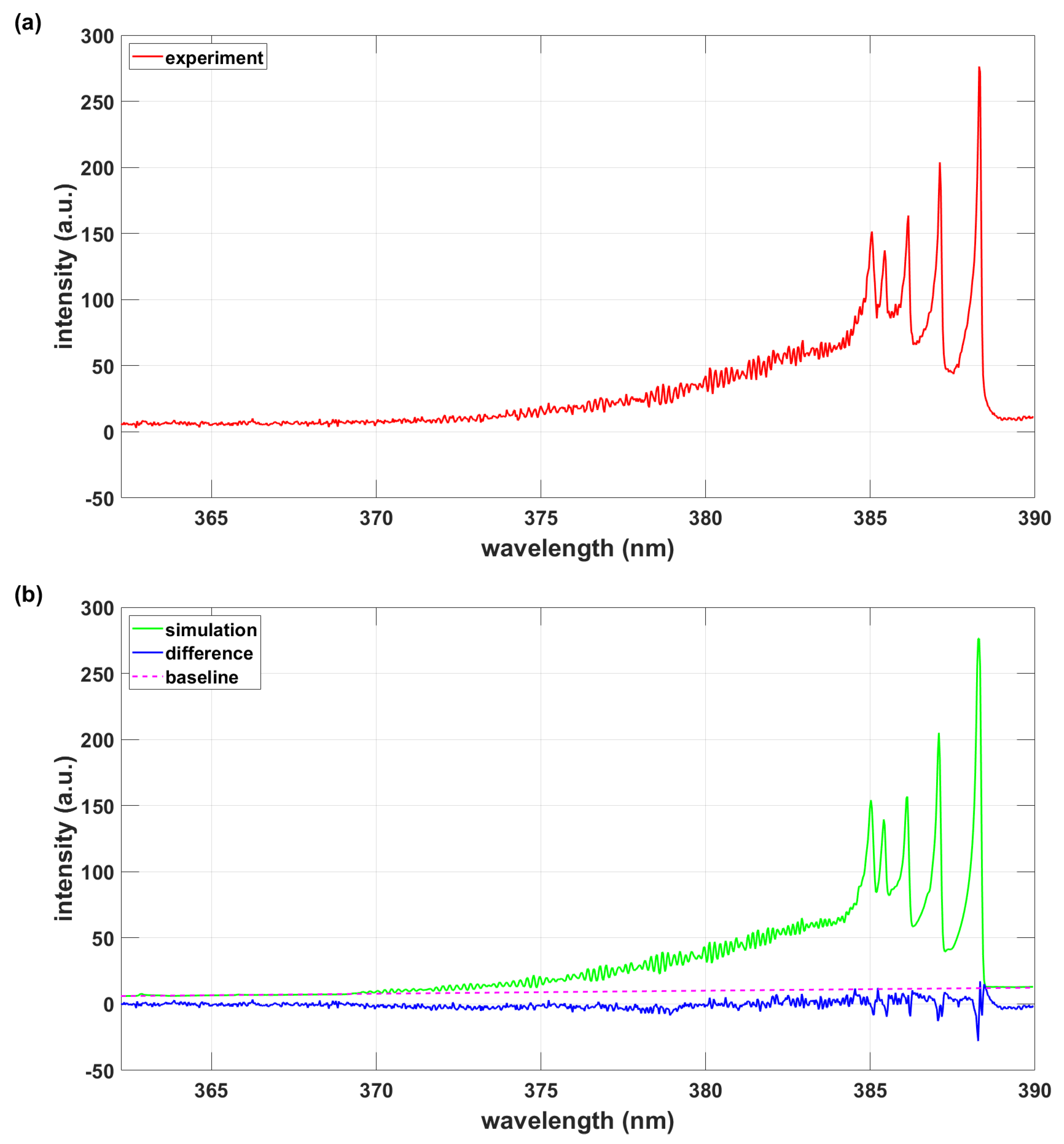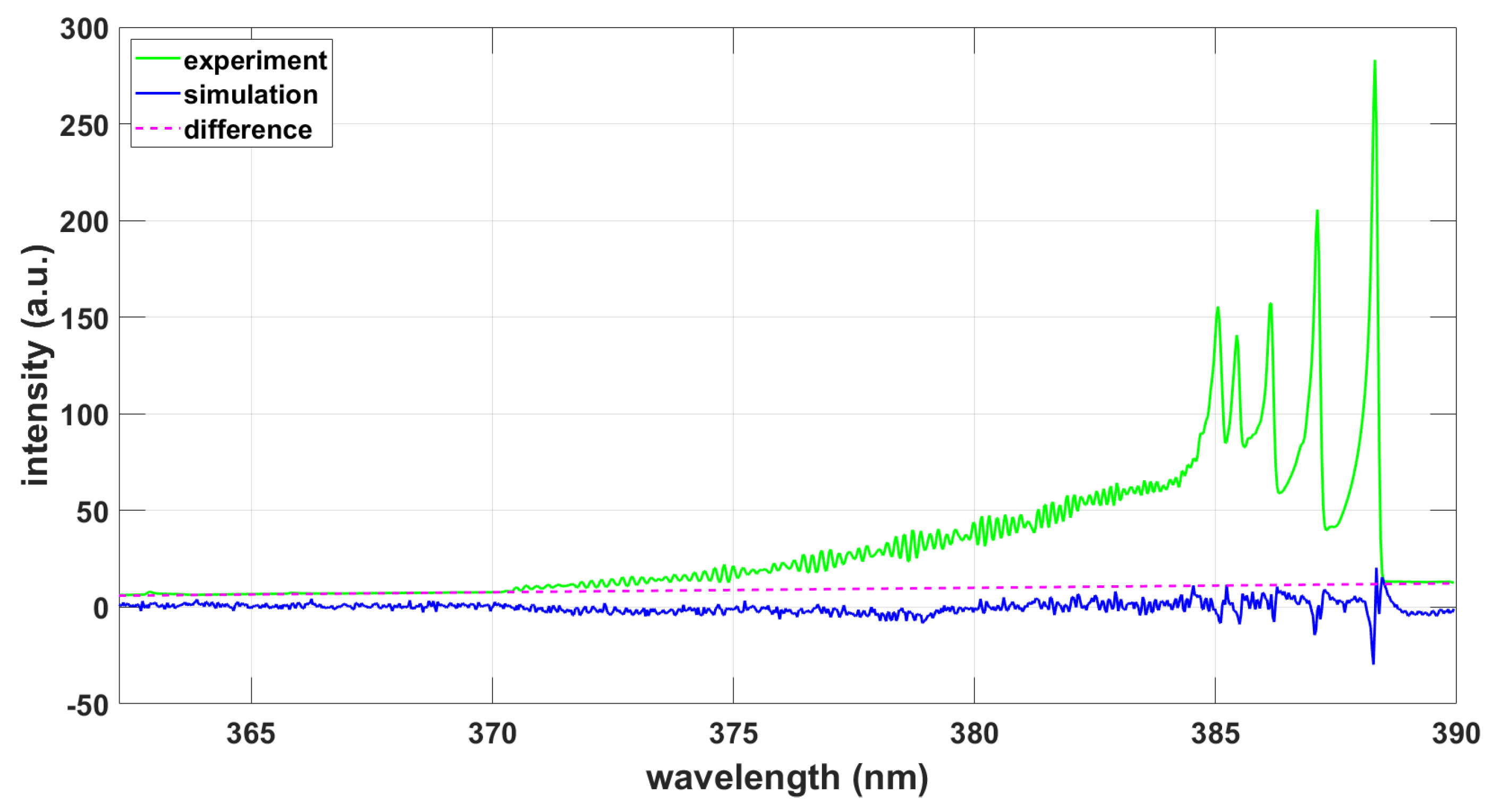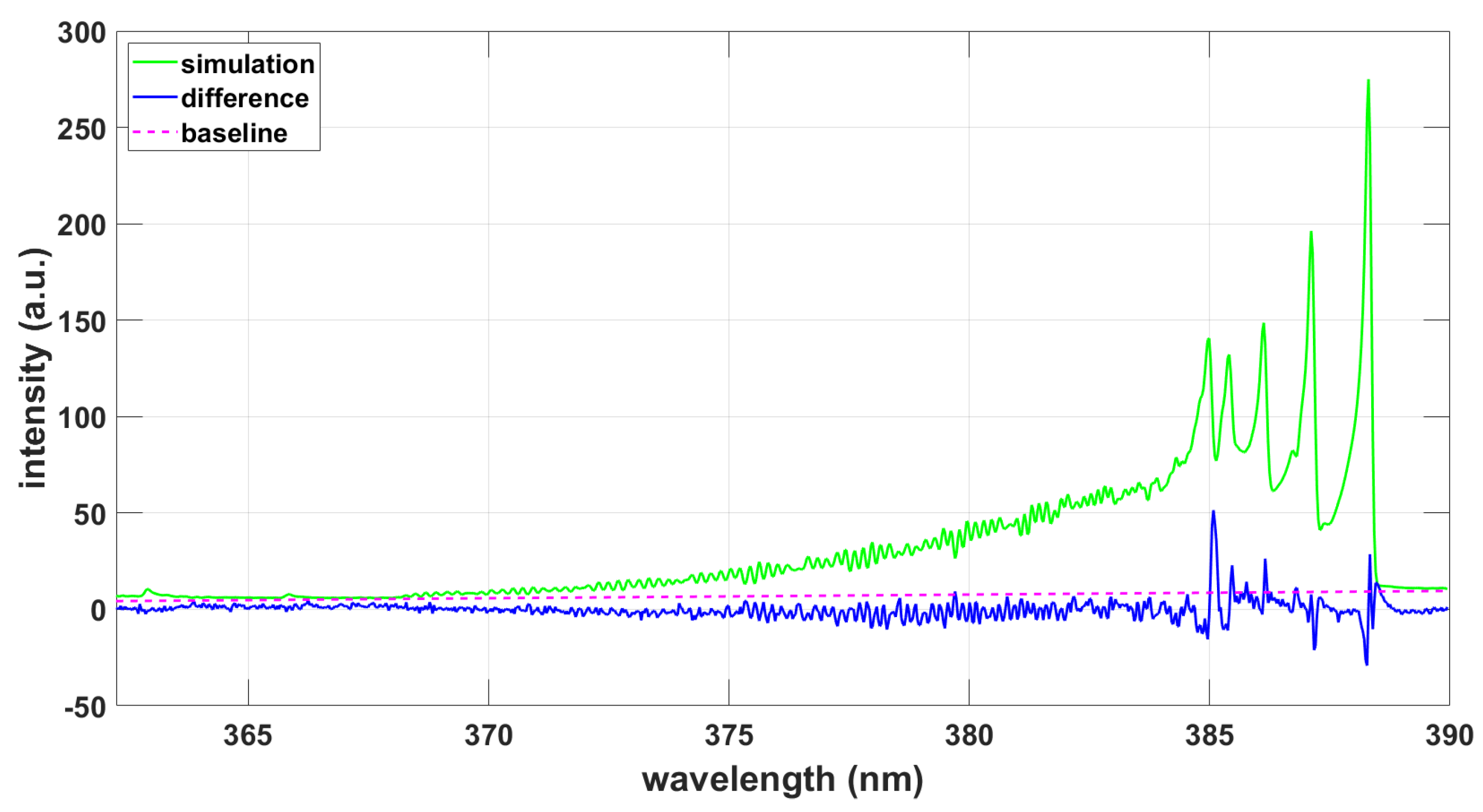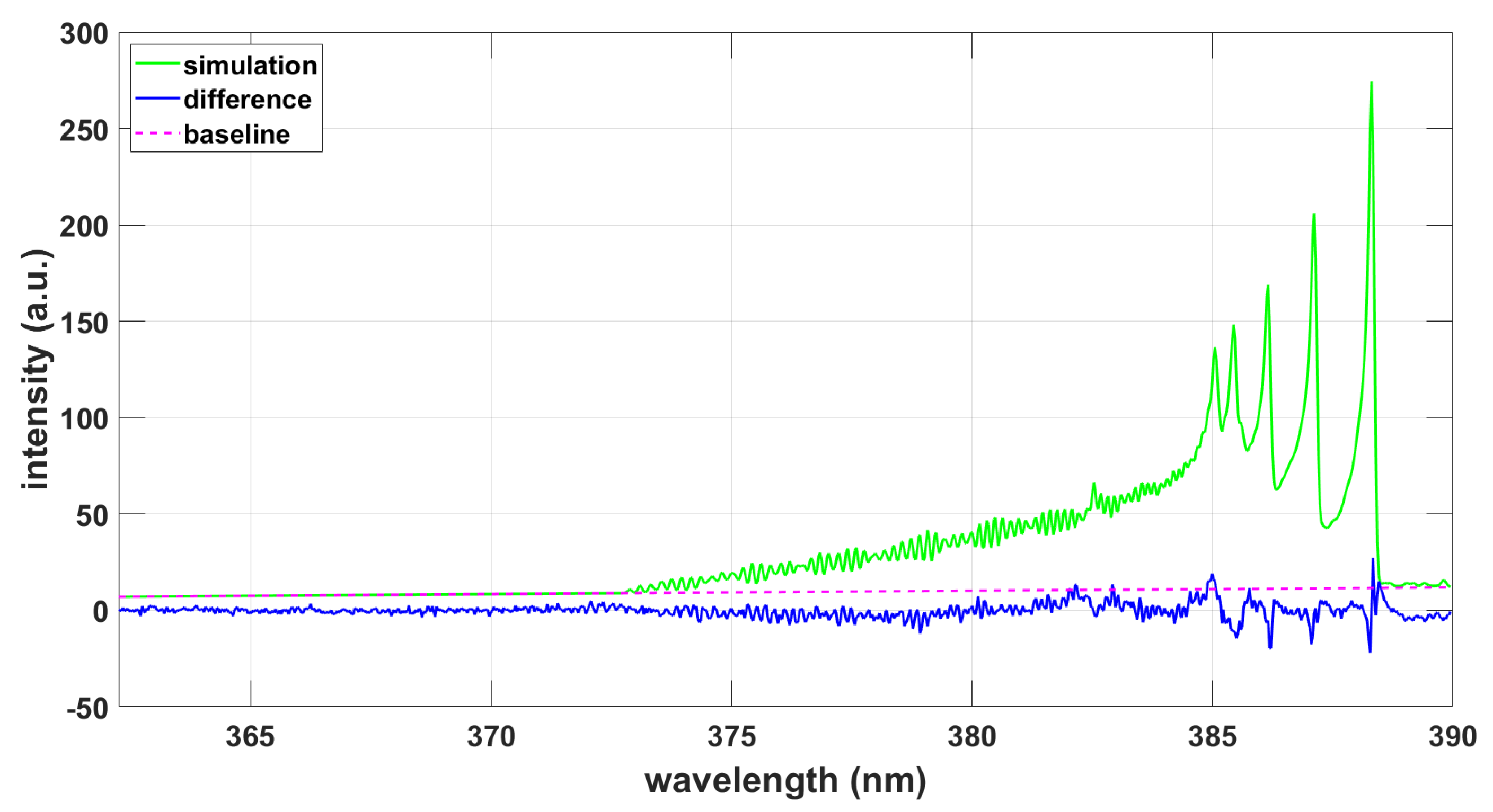1. Introduction
The diatomic molecule cyanide, CN, occurs in various forms in nature. Toxicity of cyanide motivates health studies, in particular those of hydrogen cyanide gas that kills by inhalation. Cyanide radical measurements characterize interstellar clouds including temperature inferences of the cosmic microwave background radiation [
1,
2]. The primary interest in this work are the CN violet
band systems. Extensive experimental and theoretical details convey the complexity of the CN radical [
3,
4]. Particularly the CN red systems are mentioned in a study of laboratory spectroscopy of astrophysically interesting molecules [
5].
Spectroscopy [
6,
7,
8,
9,
10] of laser-induced air plasma reveals “fingerprints” of CN early (within the first microsecond) in the plasma decay [
11]. Recent developments of laser-induced breakdown spectroscopy indicate interests in diagnosis of molecular species. This work investigates existing databases for diatomic molecules, in particular the ones for CN, for analysis of measured emission spectra. Laser-induced breakdown with 6-ns, 1064-nm radiation and associated diagnosis [
12] discusses determination of CN distribution and shock-wave phenomena in hypersonic and supersonic expansion.
For cyanide spectroscopy, one can employ the ExoMol database [
13], the LIFBASE laser-induced fluorescence database [
14], and the PGOPHER program for simulating rotational, vibrational and electronic spectra [
15]. There are of course other databases that can be accessed [
16] for diatomic molecules, including HITEMP that for example shows hydroxyl, OH, data [
17]. The ExoMol, LIFBASE, PGOPHER predictions of the CN violet
sequence are compared with experimental data. The laser-plasma recombination spectra that are utilized in the comparisons were captured following optical breakdown with picosecond laser pulses in a 1:1 molar CO
2:N
2 atmospheric gas mixture and in standard ambient temperature and pressure laboratory conditions. Astrophysical ExoMol databases are expected to work well for optical spectroscopy of laser-plasma. The measurement of molecular spectra may be accomplished with nanosecond laser-induced optical breakdown - molecular spectra are readily observed with femtosecond or picosecond laser-plasma excitation - after some time delay (of the order of larger than 100 ns for occurrence of CN in CO
2:N
2 gas mixtures) from optical breakdown when using nanosecond laser pulses. In addition, analysis is discussed with previously established line-strength data that are freely available along with MATLAB [
18] scripts for a subset of transitions associated with the CN violet and red band systems [
19,
20].
3. Results
This section elaborates analysis of recorded CN spectra of the
,
sequence. The PGOPHER-program analysis is discussed first. The full CN B-X and A-X transition data are available for the construction of simulated spectra.
Figure 1 displays measured and fitted CN violet spectra. The fitted spectrum also shows the baseline correction and difference between experimental and simulated spectra.
The spectra were captured using an intensified 1024-diode array detector and a laboratory-type Czerny-Turner (Jobin Yvon model HR-640, Fr) spectrometer. The spectral resolutions of the experimental arrangement amount to 0.11 nm (≃ 7 cm−1) and 0.033 nm (≃ 2 cm−1) for the employed 1200 and 3600 groves/mm gratings, respectively. The time-resolved measurement gate-delays were 400 nanosecond (ns), with gate-open times of 500 ns and 600 ns for the higher and lower resolution data, respectively. An average of 40 spectra were collected, consequently, the inferred temperature is an average of the line-of-sight data during the gate-open duration.
The synthetic spectrum is fitted using the PGOPHER program and an overlay of the experimental record of recorded optical multichannel analyzer (OMA) counts versus vacuum wavenumbers that are computed from the recorded air wavelengths.
Table 4 lists results for parameters that were selected for fitting. Normalized intensity units were used, i.e., the partition function is implemented. Following a separate fit for determination of the wavenumber offset of
cm
−1 (
nm - the Doppler width at ≃ 8,000 K for CN equals ≃ 0.005 nm), the selected parameters included Gaussian width, temperature, scaling, and T
vib that assesses deviation from thermodynamic equilibrium. The T
vib results confirms Boltzmann distribution equilibrium within the standard deviation.
In addition, CN B-X line positions and Einstein A-coefficients (that are converted to line strengths) are collected in a data file that is compatible with the mentioned NMT-spectral fitting program.
Figure 2 illustrates spectra determined from temperature and Gaussian linewidth fitting. The results are consistent with those obtained from the versatile PGOPHER program. The inclusion of CN A-X data in the analysis would change the inferred temperature by ≃ 0.1%.
Similarly, the recommended ExoMol databases for states and transitions were utilized to generate a subset of lines and strength for analysis with the NMT program and for the 0.033-nm resolution data. The results displayed in
Figure 3 indicate a Gaussian full-width-at-half-maximum (FWHM) of 0.038 nm, indicative of line-position differences in the ExoMol data. However, the inferred temperature appears consistent with the results illustrated in
Figure 1 and
Figure 2.
Analysis of the measured data with the CNv-lsf data reveals a temperature of T = 8140 K, and a fitted FWHM of 0.038 nm.
Figure 4 shows the fitting results.
The simulated spectra in
Figure 1,
Figure 2,
Figure 3, and
Figure 4, display superposition spectra from quite a few individual rotational-vibrational transitions of the CN B-X
sequence. Actually, small contributions from the CN A-X transition are also included in the PGOPHER and ExoMol databases.
Table 5 and
Table 6 summarize the number of lines in the data files.
Comparisons of CN B-X line position accuracies in the PGOPHER and ExoMol databases with those of the CNv-lsf database are further elaborated for the range of the 0.033-nm resolution experiments (25,725
to 26,125
) and for Einstein A-coefficients larger than 10
3 s
−1 (see first column in
Table 6).
Table 7 displays agreements of lines within the indicated wavenumber range and otherwise the same angular momentum values for upper and lower levels of the transitions.
Various aspects of the accuracy of the CNv-lsf database have been extensively tested [
19] including analysis of laser-induced fluorescence and nominal 300 K temperature Fourier transform spectra. The differences in predictions for line positions appears larger for levels with higher angular momenta,
and
J. The accuracy of line positions in the CNv-lsf database is better than 0.05
.
Table 7 reveals that PGOPHER line positions compare favorably with those in the CNv-lsf database. The ExoMol database appears acceptable within ≃ 2 wavenumbers that corresponds to a spectral resolution of ≃ 0.033 nm. However, high-temperature (≃ 8,000 K) inferences from CN B-X spectra at a 0.033-nm experimental spectral resolution appear only minimally affected (see
Figure 2 and
Figure 3).
In addition, the LIFBASE program is used for simulation of the measured spectrum. A Voigt profile of width 0.033 nm with a 30% Lorentzian contribution is selected.
Figure 5 illustrates the results. Noteworthy is that the PGOPHER program is capable of fitting Voigt profiles as well. However, Gaussian profiles are usually selected in the NMT program for modeling of the spectrometer & detector transfer function.
One of the primary interests is the use of updated ExoMol sets of line strength data that appear to be in use for extragalactic studies [
31]. Availability of an extensive line list obviously would alleviate computation of specific transitions that are investigated in laser-plasma laboratory experiments, including CN B-X violet and CN A-X red systems. The ExoMol database shows 2,285,103 transitions up to 60,000
between the three lowest electronic states,
. The PGOPHER dataset for CN A-X and B-X includes 191,109 transitions.
The CNv-lsf and CNr-lsf data contain 7,960 and 40,728 transitions, respectively. The differences in number of transitions are in part due to the number of rotational states (up to ≃ 120 in ExoMol), the cutoffs for Einstein A-coefficients and associated line strengths (see Eq. (
2)), or the establishment of sets of computed molecular parameters that fit data from high-resolution, Fourier-transform spectroscopy. As communicated in
Section 2.4, the line positions are determined from high-resolution data with a standard deviation comparable to the estimated experimental errors. The obtained, simulated line strengths are typically better than 0.05
.
The lower resolution, 0.11-nm data are analyzed using a similar approach as that for the 0.033-nm data. Following a separate fit for determination of the wavenumber offset of 0.13 cm
−1 (0.002 nm), the selected parameters included Gaussian width, temperature, and scaling.
Figure 6 illustrates the results obtained by employing the PGOPHER fitting program and the available, full CN B-X and CN A-X data set [
32]. The effect of the CN A-X transition lines is minimal for temperature inference, viz. 0.1% for the higher spectral resolution data (see
Fig. 2).
Table 8 summarizes the results of PGOPHER fitting including the standard deviations.
Figure 7 displays the results of the NMT-program using PGOPHER data. As before, the NMT-program resorts to fitting of relative intensities. In turn, the scales that are indicated in
Tabs. 4 and
8 can serve as a calibration of the detector counts in the laboratory recorded CN spectra.
The fitting of the experimental data using the PGOPHER-extracted wavenumbers, upper term values and Einstein A-coefficients (that are converted to line strengths) with the NMT program shows similar results as obtained for exclusive PGOPHER fitting.
The fitting ExoMol data using the NMT program yields a temperature of T = 9090 K for a spectral resolution of
.
Figure 8 illustrates the simulated spectrum, difference and baseline. A temperature of T = 8940 K is obtained when using CNv-lsf in the NMT program.
Figure 9 shows the results.
4. Discussion
The CN violet , sequence reveals a multitude of vibrational and rotational transitions that are usually not individually resolved in the study of laser-induced plasma emissions in the spectral range of 383 nm to 389 nm. Analysis of the 0.033-nm spectral resolution experimental emission spectrum with the PGOPHER program and use of full CN B-X data file yields CN excitation temperature of ≃ 8,100 K and a standard deviation of ≃ 200 K.
Similar results are obtained when using the CN B-X data in conjunction with a Nelder-Mead spectral fitting program. The most recent ExoMol CN data also predict a temperature within the standard deviation of the PGOPHER prediction, but there appear to be discrepancies in the ExoMol predictions near the 2-2, 3-3, and 4-4 band heads, or in the range of 385 nm to 386 nm. Analogous results are noted when using the CNv-lsf line strengths with however slightly better agreement of experimental and simulated spectra than those for ExoMol. Comparative spectra obtained from the LIFBASE program are as well largely in agreement with the measured data.
The lower, 0.11-nm resolution data in the range of 362 nm to 390 nm appear to be well predicted by the PGOPHER data. About 6% higher temperatures are predicted with the ExoMol and the CNv-lsf data. The CN violet spectra have been extensively tested in a variety of experimental studies of laser plasma.
For comprehensive comparisons of experimental and simulated spectra however the higher the spectral resolution the better. The expansive PGOPHER and ExoMol line lists allow one to predict simulated spectra consistent with laboratory laser-plasma experiments.
Figure 1.
(a) Experimental spectrum. (b) Simulation with PGOPHER, T = 8103 K, .
Figure 1.
(a) Experimental spectrum. (b) Simulation with PGOPHER, T = 8103 K, .
Figure 2.
Simulation using PGOPHER data and the NMT program, T = 8240 K, .
Figure 2.
Simulation using PGOPHER data and the NMT program, T = 8240 K, .
Figure 3.
Simulation using ExoMol data and the NMT program, T = 8150 K, .
Figure 3.
Simulation using ExoMol data and the NMT program, T = 8150 K, .
Figure 4.
Simulation using CNv-lsf data and the NMT program, T = 8140 K, .
Figure 4.
Simulation using CNv-lsf data and the NMT program, T = 8140 K, .
Figure 5.
Simulation using LIFBASE with fixed T = 8103 K, , Voigt profile with 30% Lorentzian contribution.
Figure 5.
Simulation using LIFBASE with fixed T = 8103 K, , Voigt profile with 30% Lorentzian contribution.
Figure 6.
(a) Experimental spectrum. (b) Simulation with PGOPHER, T = 8340 K, .
Figure 6.
(a) Experimental spectrum. (b) Simulation with PGOPHER, T = 8340 K, .
Figure 7.
Simulation using PGOPHER data and the NMT program, T = 8380 K, .
Figure 7.
Simulation using PGOPHER data and the NMT program, T = 8380 K, .
Figure 8.
Simulation using ExoMol data and the NMT program, T = 9090 K, .
Figure 8.
Simulation using ExoMol data and the NMT program, T = 9090 K, .
Figure 9.
Simulation using CNv-lsf data and the NMT program, T = 8940 K, .
Figure 9.
Simulation using CNv-lsf data and the NMT program, T = 8940 K, .
Table 1.
Spectroscopic constants for the A–X and B–X transitions of 12C14N.
Table 1.
Spectroscopic constants for the A–X and B–X transitions of 12C14N.
|
Constant |
X2Σ+(cm−1) |
A2Π (cm−1) |
B2Σ+(cm−1) |
|
|
0. |
9,245.28 |
25,752.0 |
|
|
2,068.59 |
1,812.5 |
2,163.9 |
|
|
13.087 |
12.60 |
20.2 |
|
|
-0.00909 |
-0.0118 |
– |
|
|
1.8997 |
1.7151 |
1.973 |
|
|
0.01736 |
0.01708 |
0.023 |
|
|
|
|
– |
|
|
|
|
|
|
|
|
|
– |
Table 2.
Constants for variation of refractive index,
n, see Equation
11.
Table 2.
Constants for variation of refractive index,
n, see Equation
11.
| Parameter |
Value |
|
272.643 |
|
1.2288 (m2) |
|
0.03555 (m4) |
Table 3.
Constants for variation of refractive index, see Equation
12.
Table 3.
Constants for variation of refractive index, see Equation
12.
| Parameter |
Value (m−2) |
|
(k0) |
238.0185 |
|
(k1) |
5,792,105 |
|
(k2) |
57.362 |
|
(k3) |
167,917 |
Table 4.
PGOPHER fitting parameters for the 0.033-nm data and results.
Table 4.
PGOPHER fitting parameters for the 0.033-nm data and results.
| Parameter |
Value |
Standard Deviation |
| Temperature (K) |
8,103 |
187 |
| Gaussian width (cm−1) |
2.2 |
0.03 |
| Scale (a.u.) |
43,960 |
790 |
| Tvib (K) |
8,108 |
146 |
Table 5.
Number of transitions of the simulated spectra in the measured experimental ranges for the 0.033-nm (25,725 to 26,125 ) and 0.11-nm (25,600 to 27,600 ) data.
Table 5.
Number of transitions of the simulated spectra in the measured experimental ranges for the 0.033-nm (25,725 to 26,125 ) and 0.11-nm (25,600 to 27,600 ) data.
| Database |
0.033-nm range CN B-X |
0.033-nm range CN B-X and A-X |
0.11-nm range CN B-X |
0.11-nm range CN B-X and A-X |
| PGOPHER |
3,598 |
5,631 |
7,115 |
14,349 |
| ExoMol |
4,302 |
17,181 |
10,499 |
78,079 |
| CNv-lsf |
2,461 |
2,461 |
3,313 |
3,313 |
Table 6.
Number of transitions of the simulated spectra in the measured experimental ranges for the 0.033-nm and 0.11-nm (see
Tab. 5) with Einstein A-coefficients larger than 10
3 s
−1.
Table 6.
Number of transitions of the simulated spectra in the measured experimental ranges for the 0.033-nm and 0.11-nm (see
Tab. 5) with Einstein A-coefficients larger than 10
3 s
−1.
| Database |
0.033-nm range CN B-X |
0.033-nm range CN B-X and A-X |
0.11-nm range CN B-X |
0.11-nm range CN B-X and A-X |
| PGOPHER |
3,205 |
4,532 |
6,187 |
9,958 |
| ExoMol |
3,625 |
8,270 |
8,259 |
28,274 |
| CNv-lsf |
2,461 |
2,461 |
3,313 |
3,313 |
Table 7.
Subset CN B-X lines of the PGOPHER and ExoMol data that agree within of 2,461 CN B-X transitions in the CNv-lsf data for the 0.033-nm range (25,725 to 26,125 ).
Table 7.
Subset CN B-X lines of the PGOPHER and ExoMol data that agree within of 2,461 CN B-X transitions in the CNv-lsf data for the 0.033-nm range (25,725 to 26,125 ).
| Database |
< 0.05 |
< 0.2
|
< 1.0
|
< 2.0
|
| PGOPHER |
1,200 |
1,422 |
1,823 |
2,012 |
| ExoMol |
158 |
463 |
1,266 |
1,935 |
Table 8.
PGOPHER fitting parameters for the 0.11-nm data and results.
Table 8.
PGOPHER fitting parameters for the 0.11-nm data and results.
| Parameter |
Value |
Standard Deviation |
| Temperature (K) |
8,340 |
43 |
| Gaussian width (cm−1) |
7.1 |
0.07 |
| Scale (a.u.) |
107,300 |
850 |
